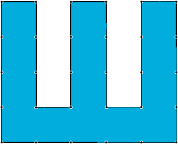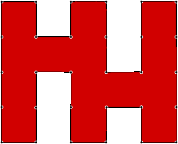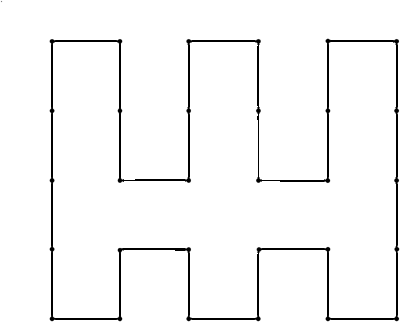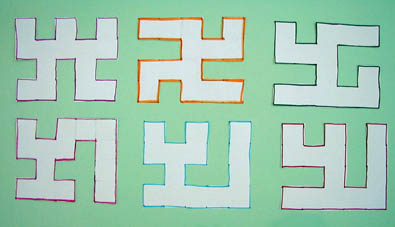

 |
Dot-to-Dot |
 |
Dot-to-Dot Pictures 1
This lesson can be taught in early grades, or in higher grades as an introduction to Dot to dot pictures 2.
Task
Students are given a 5 by 6 grid of dots like the one shown below ( the horizontal
and vertical distance between dots should be 1 inch). Click on the grid to get
a copy to print.
Rules.
After you finish, color the shape that is drawn, and cut it out.
Example.

Later the shapes should be displayed in the classroom.
Questions.
Answering why the perimeter is always 30 inches is easy. The closed path traversing all 30 points contains exactly 30 one-inch segments, and each of them separates the inside from the outside of the figure, so it is part of the border.
The question about the area is more difficult. One needs to show that the figure can be built by adding one square at a time, by attaching the square by just one edge. So the total perimeter is 2*(the number of squares) + 2 = 30. We solve this for the number of squares. So the number of squares is 14.
Picture of dot-to-dot solutions done by students.

Dot-to-Dot Pictures 2
Prerequisite: Dot-to-dot pictures 1.
Task.
We have been making figures from a 5 by 6 grid. Keeping exactly the same rules,
from what other sizes of rectangular grids can we make pictures?
Let students investigate this for a while. It is not difficult to form the hypothesis that:
You can make a picture using all points of an n by m grid if and only if m * n is even.
Showing that when n*m is even, then we can make a figure, is easy. Here is
one way to do it.
First, if the figure has only two rows, then it has an even number of dots.
And we can make a picture like this:

Now we need to show that, when we have already made a figure with an even number of dots, we can always add two lines of dots (an even number) to it, coming up with a new figure that has an even number of dots.
Since the original figure and the newly added figure both consist of an even
number of dots, after they are joined, the newly created figure also has an
even number of dots. So now we know that you can make a picture using all points
of an n by m grid if n*m is even.
Now we need to show that a rectangle with an odd number of points cannot be
turned into a picture. Here is one proof:
Every closed line goes …x, o, x, o, …, so it contains as many o’s as it does x’s.
But because n*m is odd, the numbers of x’s and o’s in the grid are not equal, so no closed line will contain all of them.
Remarks.
Here we have an example of a proof that something cannot be done. So we do not
need to waste our time trying.
Expect that some students will have difficulty with understanding this
reasoning. It helps if they discover beforehand, by looking at all cases,
that they cannot make a picture from a square that is 3 dots by 3 dots.
Another proof.
If the students already know that in every picture the perimeter in inches
is equal to the number of dots, which is also equal to
2*(number of squares in the figure) + 2,
then they can deduce that the number of points cannot be odd.
All the solutions we know of (44) to the dot-to-dot pictures are shown below. (If you find more, please email them to baggett@nmsu.edu.)
(click on the small pictures to get a larger version)
Category 1 solutions (2 squares in center column) 6 solutions
Category 2 solutions (3 squares in center column) 18 solutions
Category 3 solutions ( 4 squares in center column) 20 solutions